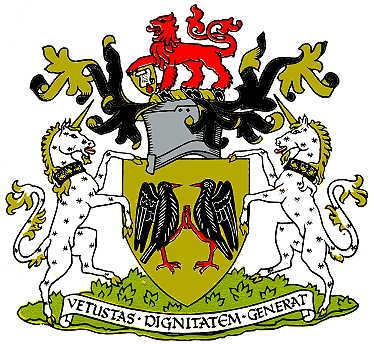East Retford
| Heraldry of the World |
| British heraldry portal Civic heraldry of the United Kingdom |
|
EAST RETFORD (Borough)
Incorporated into 1974 Bassetlaw
Official blazon
Arms : Or, two choughs, wings elevated and addorsed, respecting one another, their interior legs elevated and the claws conjoined proper.
Crest : On a wreath or and sable, a lion passant, queue fourchée, gules resting the dexter paw on a escutcheon or charged with a representation of a deed proper, the seal pendent also gules.
Supporters : On either side a unicorne ermine, armed, maned, tufted and unguled or, gorged with a collar sable charged with three escallops gold.
Motto :Vetustas dignitatem generat - Age begets dignity
Origin/meaning
The arms were officially granted on November 4, 1940.
The two choughs facing each other are from an old seal of the Borough.
The crest is based upon a design on a mace presented to the Corporation in 1679 by Sir Edward Nevile, with a few changes. A small shield replaces the original rose upon which the lion rested its paw and its tail now forked for distinction. The deed stands for the Borough's ancient charters, which date from the thirteenth century onwards.
The unicorns are from the heraldry of Lord Galway, whose ancestors were High Stewards of the Borough, and the shells are from the arms of the Rt. Hon. F. J. Savile Foljambe, appointed High Steward in 1880.
Contact and Support
Partners:
Your logo here ?
Contact us
© since 1995, Heraldry of the World, Ralf Hartemink
Index of the site
Literature : Scott-Giles, C.W. : Civic heraldry of England and Wales, London, 1932; Briggs, G. : Civic and corporate heraldry. Heraldry Today, Ramsbury, 1971.


